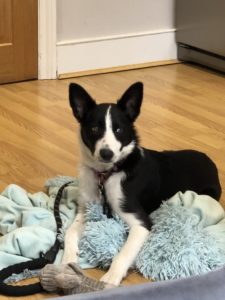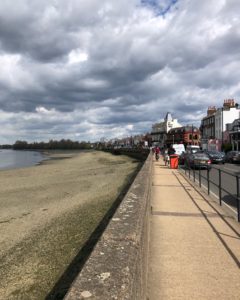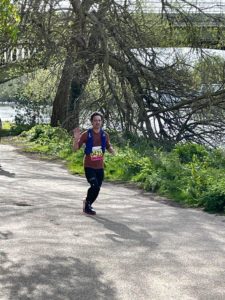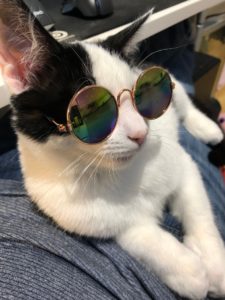You may recall the previous entry about running. In the middle of the Hampton Court Half-marathon I decided that entering the race was the dumbest thing I had ever done, and I was certain I’d never, ever run a full 26.2 miles. At the end of the race, I felt exhausted and triumphant, and I was already planning my next race. The next race was the Kew Gardens Half, which was scheduled for last weekend (10 April).
The training block started in December, which meant sticking to a decent running schedule while we were visiting family in Missouri. I put together a plan modified from the Hanson Half-marathon plan and did a decent job holding to it with lots of runs by Fellows Lake and even one in the middle of Springfield. Things were going great until mid-January when I was playing football and felt something like a hot knife drive into the bottom of my kneecap. It passed quickly, but it came back with a vengeance the next day while I was walking to the kids’ school. It was strange because it was so sporadic. I could walk a hundred meters with no issues at all, only to be hit by a dagger to the kneecap with the next step.
In retrospect, I probably should have seen a professional. In reality, I did some research and found that my symptoms matched patellofemoral pain syndrome aka PFPS aka yet another square on my bingo card of runner’s injuries. Rehab for PFPS is much like rehab for other running injuries: rest until the acute pain subsides (a few days), then strengthen the glutes and legs. I had been doing those exercises, but I am fairly convinced that the bigger issue was the ramp in the training plan’s mileage coupled with the addition of intervals and tempo runs. After years of desk work, my legs weren’t able to handle multiple new stressors at once.
Reader, I have done so many leg raises and butterflies. The good news is: they worked. I was healthy enough to get back to running in March, but I was cautious. I stayed at my easy pace for everything. No intervals. No tempo runs. Only limited strides. I had a few little twinges along the way but felt near 100% by race day.
The morning of the race was cold. Three Celsius (37F), but it was due to warm up pretty quickly. The original plan was shorts and a t-shirt, but I didn’t want to freeze my tail off before the race started, so I decided to go with running tights, a long-sleeve breathable base layer, and a warmer quarter-zip top I could stuff into my camelback prior to the race start. In retrospect, knowing that I would get warmer from running plus the ambient air temperature coming up to about 8C (46F), I should have stuck with the shorts and t-shirt. It wasn’t a huge issue, but I was definitely uncomfortably warm for the last few miles. I now understand why marathoners wear and discard old sweatshirts at the starting line.
The race organizers put me into corral 1. At the point I signed up, I thought I’d finish around 1:45, and that made sense. By race day I was hoping to finish around 2:00. Anything under 2:00 was a bonus, and I didn’t think my 1:55 at Hampton Court was in danger.
I made the mistake of shuffling to the back of the corral prior to the start. Little did I know that the back of the corral was actually the front of the corral, and by the time I realized I was next to the 1:30 pacers, things were too tight to wriggle toward the back.
I started much too fast.
My plan was to put in a few 9:00 minute miles before dropping to 8:45 for a few more and then finishing at 8:30. Instead, I came out at 7:50. Even there, I was being passed constantly. It was a bit demoralizing, and I wish I had found a group of people running at a similar speed.
Around the 3 mile mark, I settled into my 8:30 rhythm, and it felt good. I was still being passed by faster runners, but much less frequently. I cruised along (still being passed frequently) through mile 7.5, where I saw Carissa and our friend Yvette waiting at Twickenham Bridge and cheering for me. That was a big lift, just as I was starting to flag.
Around mile 9.5 the fatigue started to creep in. My pace dropped back to about 9:00, and I shuffled along the loop through Ham. When we came back out to the river, I realized my form had collapsed. My shoulders were slumped and my feet were shuffling. I focused on getting my back straight, my glutes firing, and my arms swinging. I repeated what has become my running mantra: every run is a gift. When I’m tired, when it’s cold, when it’s dark, I remind myself what it felt like to be injured and unable to run. I remind myself that every run is a gift, and this is a sport that is about the journey far more than it is the destination (at my paces, anyway). The mantra and the form corrections helped me get back to the 8:30 pace. It wasn’t as easy as before, but it was still sustainable, so I powered through back to Twickenham Bridge where I saw Carissa and Yvette again around mile 11.
At that point, I thought I’d have my revenge on the people who had been passing me. With two miles left, I wanted to up my pace and start picking off stragglers. That lasted about a quarter-mile before I dropped back to about 8:40. My fitness didn’t quite match my ambition. I kept my form and put another burst to clear a group of runners, then cruised at 8:30 to the last 100 meters. I focused on a straight back and high knees, and I ran down a half-dozen people. Two other people managed to pass me in the final 25 meters, but I felt like I finished strong.
My final time of 1:51:15 wasn’t as good as the 1:44 I was targeting in January, but far better than the 2:00 I was hoping to hit at the start of the race. I felt more in control this time, especially the last few miles. I could have held the overall 8:27 pace for a few more miles, but there’s zero chance I could hold it for another 13.1.
I ran with my hydration vest and two 500ml flasks of Tailwind. I only drank about half of each and didn’t otherwise take on any water. In retrospect, I could have skipped the vest and Tailwind, with maybe a single gel around mile 9 to give myself a kick for the final quarter. On the other hand, part of using the vest was to test it in race conditions prior to running a full marathon later in the year, and it worked great. I’ll keep it for long runs when I don’t have water stations and for the full marathon when I actually need nutrition mid-race.
For my next half I have a few takeaways:
- Skip the hydration vest and just take a gel in my pocket
- Find the right pacers in the corral
- Dress for the weather mid-race more than the start
I’m aiming to run a full marathon this autumn, ideally under 4 hours, though the estimators currently put me at about 4:10 based on my weekly training mileage and my half finishing time. I’ll try to bring that down if I can do it while staying healthy.
Aside from running, things are good in England. We’ve had a few birthdays recently, including some delicious birthday dinners and birthday cakes. We have had Yvette, a friend from one of my very first writing groups, staying with us for a few days, which has provided a good excuse to get out of the house. The pets have not murdered each other yet, and sometimes they can play together for whole minutes at a time. Aela continues to be highly intelligent and highly energetic. We’re all looking forward to puppy school starting later this month.
I’m taking a couple rest days, but I’ll be back on the trails and river paths this weekend, base building for the autumn marathon.
Every run is a gift.




